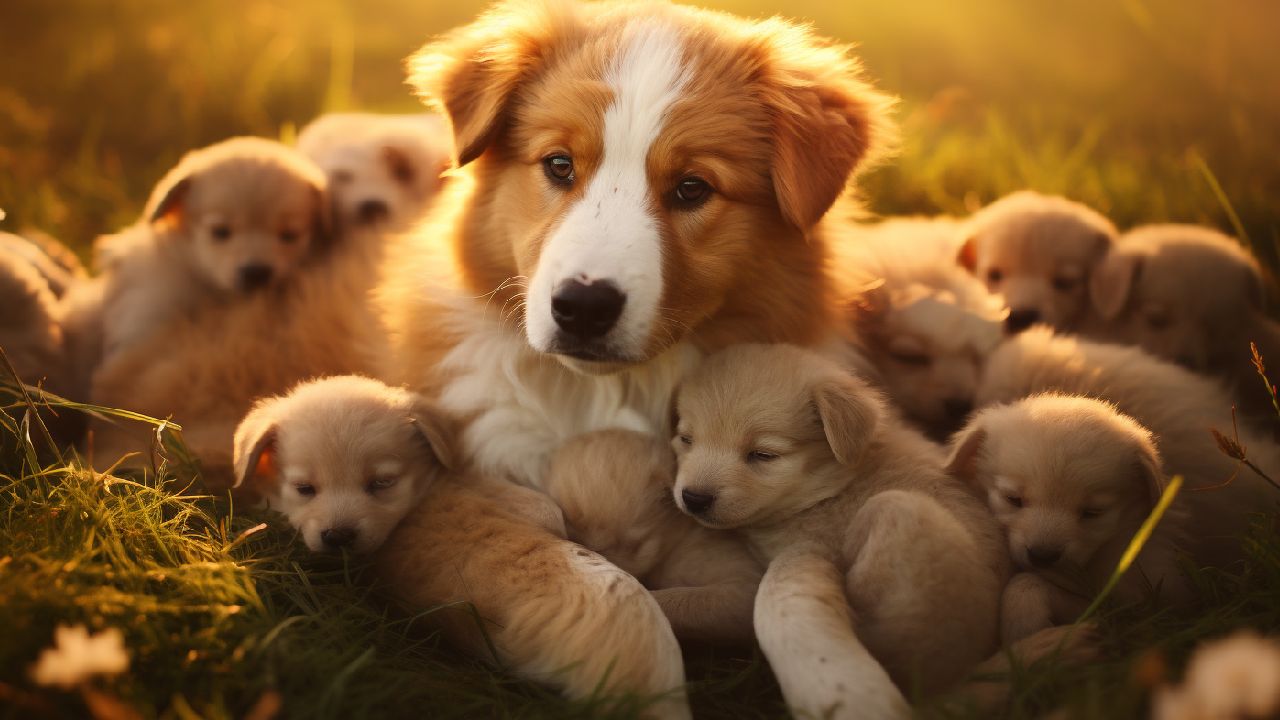Dogs, often called man’s best friend, always amaze us with their incredible range of attributes. One of the most intriguing aspects of canine biology is their ability to reproduce and, more specifically, the size of the litter they can produce.
For dog lovers and breeders alike, the question of how many puppies a dog can have is both fascinating and essential knowledge. This article promises to shed light on the mysteries surrounding a dog’s litter size.
How Many Puppies Can a Dog Have?
While there isn’t a one-size-fits-all answer to this question, it’s crucial to understand that the number of puppies in a litter can vary significantly from one dog to another. On average, dogs can give birth to a litter size ranging from one to twelve puppies, but this range can extend further under specific circumstances.
In perspective, smaller breeds tend to have fewer puppies in a litter, typically between one and five, while larger species can have larger litter, ranging from six to twelve.
The Average litter sizes for ten famous Dog breeds
Labrador Retriever
- Average Litter Size: 6-8 puppies
- Description: Labrador Retrievers are known for their friendly and outgoing nature. They are medium to large-sized dogs with a short, dense coat. Labs are excellent family pets and are often used as working dogs in roles such as search and rescue or as assistance dogs.
German Shepherd
- Average Litter Size: 6-7 puppies
- Description: German Shepherds are brilliant and versatile dogs. Due to their trainability and loyalty, they are often used in law enforcement and as service animals. These dogs are known for their distinctive black and tan coat.
Golden Retriever
- Average Litter Size: 6-8 puppies
- Description: Golden Retrievers are friendly, intelligent, and easily trainable. They have a beautiful golden coat and are known for their gentle temperament. These dogs make excellent family pets and are often used as therapy dogs.
Bulldog
- Average Litter Size: 4-5 puppies
- Description: Bulldogs are known for their distinctive wrinkled face and loose, jowly appearance. They have a calm and affectionate disposition, making them great companions. Despite their appearance, they are solid and sturdy dogs.
Poodle
- Average Litter Size: 4-6 puppies
- Description: Poodles are highly intelligent and come in various sizes, including standard, miniature, and toy. They have a hypoallergenic curly coat, making them a good choice for allergy sufferers. Poodles are known for their elegance and can excel in various dog sports.
Beagle
- Average Litter Size: 6-8 puppies
- Description: Beagles are small to medium-sized dogs with a keen sense of smell. They are friendly and pleasant, making them great family pets. Beagles are often used as scent hounds in hunting.
Yorkshire Terrier
- Average Litter Size: 2-4 puppies
- Description: Yorkies are tiny, but they have a big personality. They are known for their long, silky coats and spunky attitude. Despite their small size, they can be aggressive and protective.
Dachshund
- Average Litter Size: 4-6 puppies
- Description: Dachshunds, often called “wiener dogs,” have long bodies and short legs. They are playful and have a hunting instinct. These dogs can come in various coat colors and patterns.
Boxer
- Average Litter Size: 6-8 puppies
- Description: Boxers are solid and muscular dogs known for their boundless energy and loyalty. They are great family dogs and are protective by nature. Boxers have a short coat and distinctive square head.
Siberian Husky
- Average Litter Size: 4-6 puppies
- Description: Huskies are known for their striking blue eyes and thick double coat. They are friendly, and energetic, and thrive in colder climates. These dogs have a strong prey drive and love to run and play.

Factors Influencing Dog’s Litter Size
The number of puppies a dog can have is not determined by chance but rather by a combination of various factors, including:
1. Breed
Different dog breeds have distinct tendencies when it comes to litter size. Smaller species, such as Chihuahuas and Dachshunds, generally have smaller litters. Conversely, larger breeds like Golden Retrievers and Great Danes tend to have larger litters. This variation is partly due to the physical constraints of the dog’s body size.
2. Age
A dog’s age plays a significant role in its ability to have puppies. Younger dogs, particularly those under two years old, may have smaller litters. As a dog matures, its fertility typically increases and it may have larger litters. However, there is an age limit beyond which it becomes riskier for a dog to give birth.
3. Health
The overall health of the mother dog plays a vital role in litter size. A well-nourished and physically fit dog is likelier to have a larger litter than a malnourished or unhealthy one. Proper prenatal care and a balanced diet during pregnancy can positively impact litter size.
4. Genetics
Genetics is a significant factor in a dog’s litter size. If a dog comes from a lineage known for large litters, it is more likely to produce larger ones. Conversely, if a dog’s genetic background leans toward smaller litters, it will tend to follow suit.
5. Hormones
Hormonal factors also come into play during a dog’s pregnancy. The release of hormones like progesterone and estrogen can influence the development of the uterine lining and, consequently, the number of puppies that can be carried to full term.
6. Previous Litter Size
Interestingly, a dog’s previous litter size can impact future litters. If a dog had a large litter earlier in pregnancy, it may be more likely to have another large litter in subsequent pregnancies.
Understanding the Pregnancy Process in Dogs
The pregnancy journey in dogs is a remarkable and crucial phase in a dog’s life. Understanding the pregnancy process in dogs allows you to provide the best care and support during this significant time in a dog’s life.
This knowledge is invaluable whether you’re a dog owner, breeder, or simply curious about canine reproduction; it’s essential to grasp this process well.
Dog’s Litter Size
A litter of puppies refers to all the puppies born from a single pregnancy. Interestingly, puppies from the same litter can have different fathers, a phenomenon known as superfecundation, which occurs when a female dog mates with multiple males during her fertile period.
The Journey to Motherhood
A dog’s journey to motherhood is a remarkable and complex process. After mating, the female dog undergoes a pregnancy of about 63 days. During this time, her body undergoes significant changes to nurture and protect the developing embryos.
The yolk sac initially nourishes the puppies, and as the pregnancy progresses, the placenta takes over, providing essential nutrients and oxygen to the growing fetuses. A dog’s pregnancy is divided into three distinct trimesters, each marked by specific developments:
1. First Trimester
The first trimester begins with conception and lasts for approximately 21 days. During this period, the fertilized eggs travel down the fallopian tubes to implant in the uterus. The embryo undergoes rapid cell division, and the mother may exhibit subtle changes in behavior and appetite.
2. Second Trimester
The second trimester, spanning days 21 to 42, sees the puppies’ organs forming, and their sex is determined. The mother’s abdomen expands visibly, and her appetite typically increases. This is a critical period for the puppies’ development, and the mother requires proper nutrition and care.
3. Third Trimester
The puppies increase in the final trimester, lasting from day 42 until birth. The mother may become more restless and seek out a suitable nesting place. It’s crucial to provide her with a comfortable and secure environment.
Sibling Dynamics
Born in a litter, these siblings share a unique bond and participate in complex dynamics that play a crucial role in their development and future interactions. Understanding the intricacies of sibling dynamics among littermates sheds light on the social and emotional aspects of a dog’s life.
The Bond Between Littermates
The bond formed between littermates is often solid and enduring. These puppies have spent their earliest moments together, sharing warmth, comfort, and their mother’s care. This early cohabitation creates a deep familiarity and kinship that can last a lifetime.
Many dog owners and breeders attest to the special connection between littermates, even if they go on to separate homes later. Littermates engage in various behaviors that strengthen their bond.
They often sleep huddled together, providing warmth and a sense of security. Play is vital to their relationship, allowing them to develop crucial social skills. They learn bite inhibition and communication through rough-and-tumble play, which is essential for healthy interactions with other dogs later in life.

Competition and Development
Despite the close bond, sibling dynamics also involve competition. From birth, littermates compete for their mother’s attention and access to her milk. This competition continues as they grow and start exploring their environment.
Puppies may compete for toys, food, and affection from humans. This rivalry, while natural, can provide valuable life lessons.
Competition among littermates can lead to the development of essential life skills. Puppies learn to negotiate, communicate, and establish boundaries. These lessons are crucial for their overall social development. They also help prepare them for interactions with other dogs and humans beyond the litter.
Littermates also serve as mirrors for each other’s behavior. They learn by observing and imitating their siblings. This observational learning extends to housetraining and other behaviors, making it easier for them to adapt to their new homes when the time comes.
As they grow, sibling dynamics may change. Some littermates may become more dominant, while others take on more submissive roles. This variation in personality and behavior is natural and contributes to the rich diversity of individual dogs.
Largest Litter Ever Recorded
Now, let’s turn our attention to the extraordinary case of the largest litter of puppies ever recorded. In the annals of canine history, a Neapolitan Mastiff named Tia holds this remarkable record. Tia’s story is a testament to the incredible potential of canine reproduction.
Tia’s litter, born in the United Kingdom in 2004, astounded veterinarians, dog breeders, and animal enthusiasts alike. This devoted mother gave birth to 24 puppies in a single litter. This astonishing event drew worldwide attention and left everyone in awe of the canine reproductive system.
The largest litter ever recorded, as exemplified by Tia the Neapolitan Mastiff, serves as a testament to the biological marvels of the animal kingdom.
Conclusion
The question of how many puppies a dog can have is captivating. While we’ve explored the factors that influence litter size, it’s clear that the miracle of life in dogs is marked by remarkable diversity. In the end, whether a dog has a few or many puppies, the key is to ensure the health and well-being of the mother and her precious pups during this incredible life journey.

FAQs
How can I support my pregnant dog to ensure a healthy litter size?
To support a pregnant dog and potentially increase litter size, provide proper veterinary care, a balanced diet, and a comfortable, stress-free environment. Regular vet check-ups during pregnancy are crucial.
Is it common for dogs to have huge litter like the “Largest Litter Ever Recorded”?
Huge litters, like the “Largest Litter Ever Recorded” of 24 puppies, are infrequent occurrences. Such cases are outliers and not representative of the average dog’s litter size.
Can a dog have only one puppy in a litter?
A dog can have only one puppy in a litter. This is known as a “singleton” litter. Singleton puppies may receive extra attention and care since they don’t have littermates to interact with.
Are there risks associated with massive litter for the mother and puppies?
Large litters can pose risks to both the mother and puppies. The mother may struggle to feed and care for many puppies, and the puppies may face competition for resources, potentially leading to health issues.
Is there a way to predict a dog’s litter size before pregnancy?
Unfortunately, there’s no foolproof way to predict a dog’s litter size before pregnancy. While factors like breed and genetics can provide some clues, the number of puppies is often uncertain until the mother gives birth.






Curious about average litter sizes! Our Golden had a big litter last year, and it was a whirlwind. Share your litter stories! 🐾